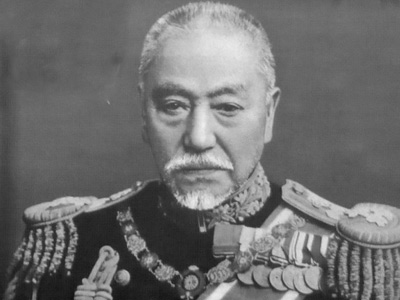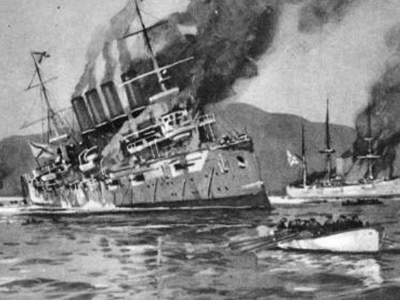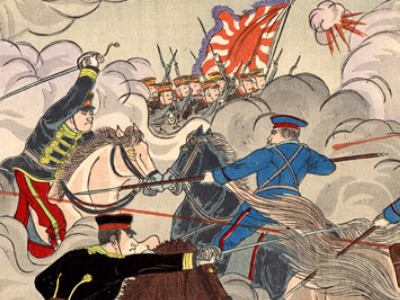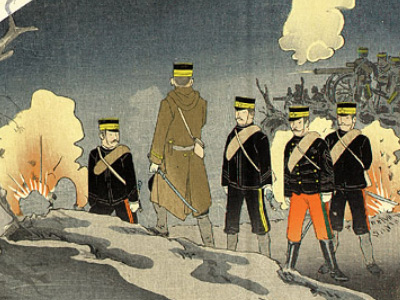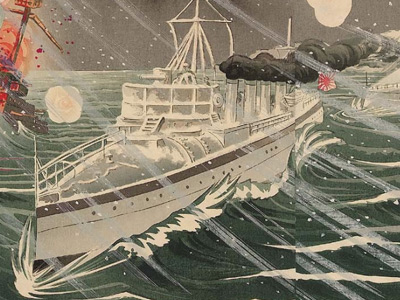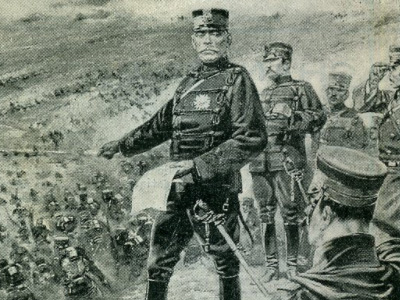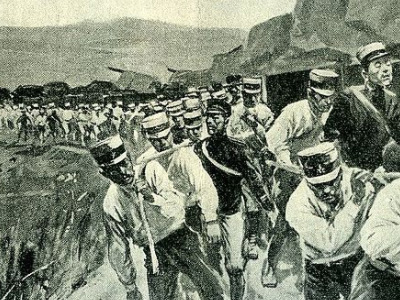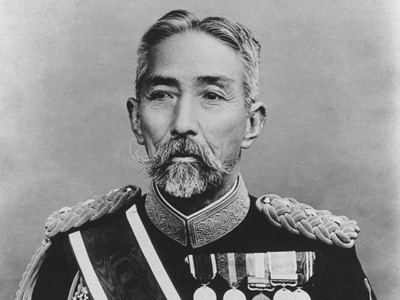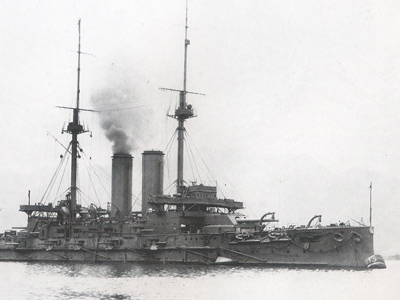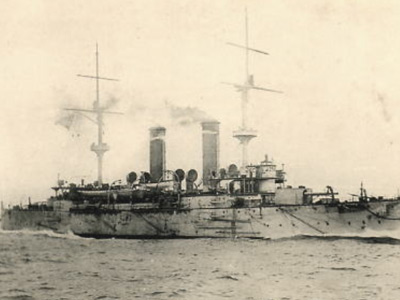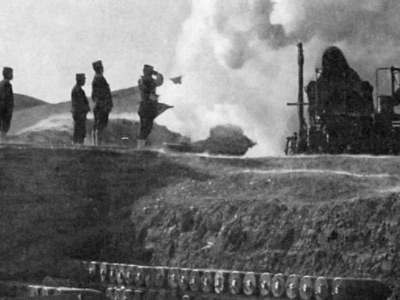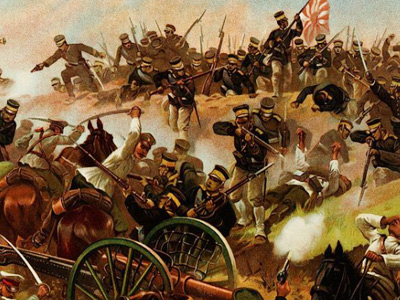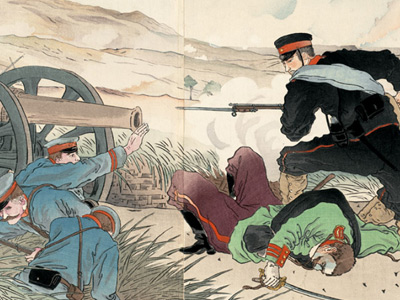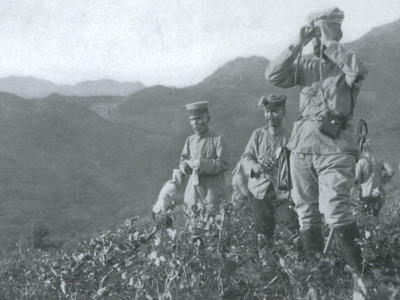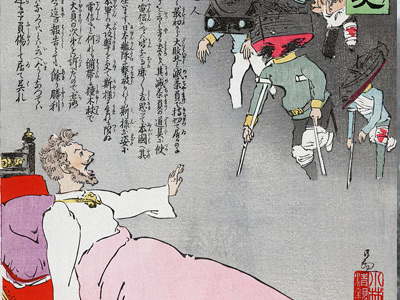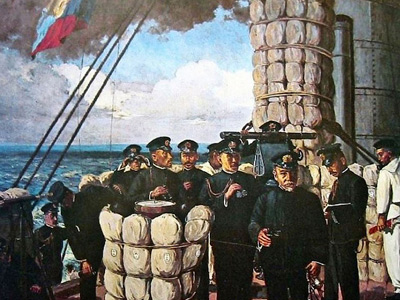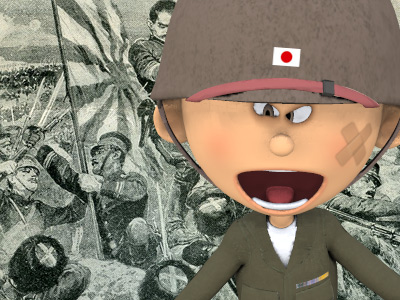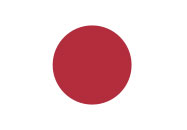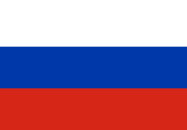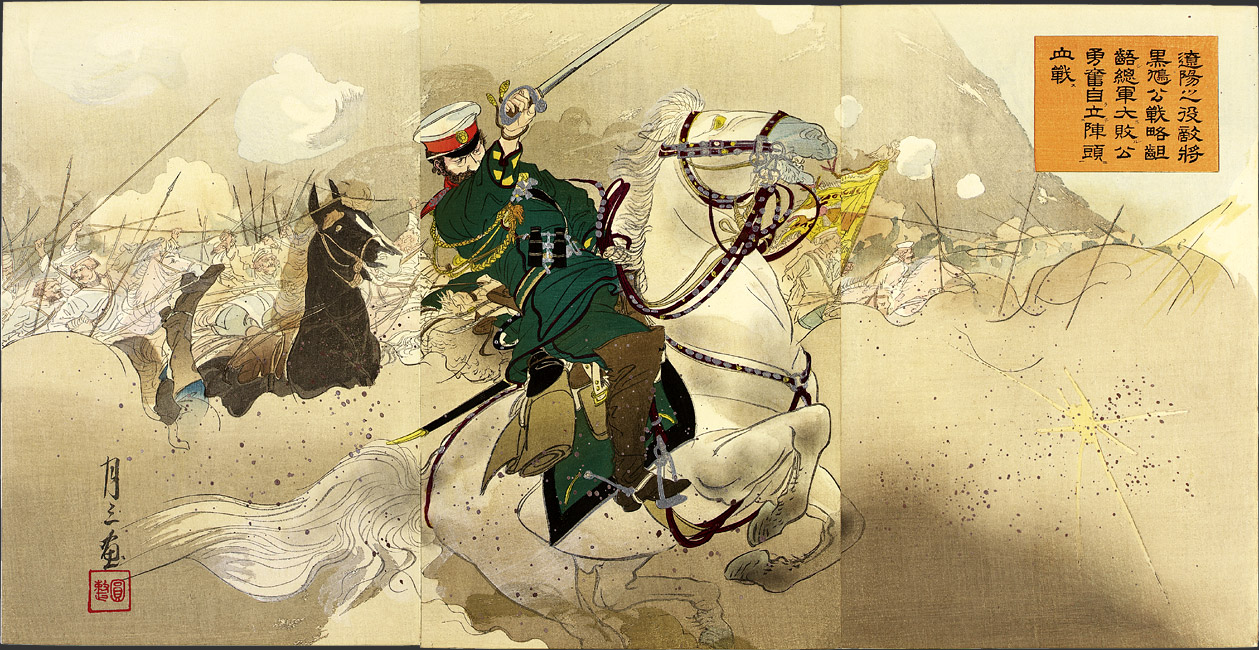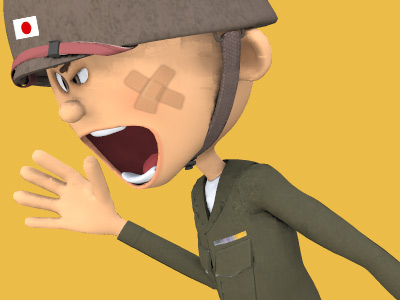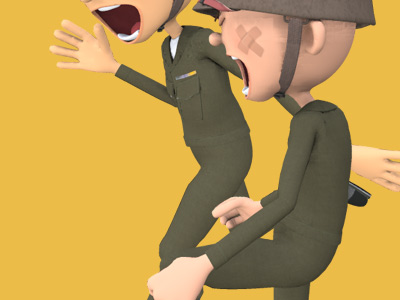Russo-Japanese War (1904–1905)
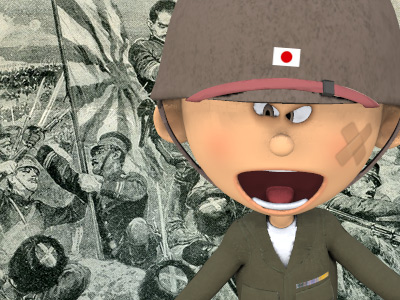
Campaign of 1904
Port Arthur, on the Liaodong Peninsula in the south of Manchuria, had been fortified into a major naval base by the Russian Imperial Army. Since it needed to control the sea in order to fight a war on the Asian mainland, Japan's first military objective was to neutralize the Russian fleet at Port Arthur.
Battle of Port Arthur
On the night of 8 February 1904, the Japanese fleet under Admiral Tōgō Heihachirō opened the war with a surprise torpedo boat destroyer attack on the Russian ships at Port Arthur. The attack heavily damaged the Tsesarevich and Retvizan, the heaviest battleships in Russia's far Eastern theater, and the 6,600 ton cruiser Pallada. These attacks developed into the Battle of Port Arthur the next morning. A series of indecisive naval engagements followed, in which Admiral Tōgō was unable to attack the Russian fleet successfully as it was protected by the shore batteries of the harbour, and the Russians were reluctant to leave the harbour for the open seas, especially after the death of Admiral Stepan Osipovich Makarov on 13 April 1904. Although the actual Battle of Port Arthur was indecisive, the initial attacks had a devastating psychological effect on Russia Russian Empire was an empire and the final period of the Russian monarchy from 1721 to 1917, ruling across large parts of Eurasia. The rise of the Russian Empire coincided with the decline of neighbouring rival powers: the Swedish Empire, the Polish–Lithuanian Commonwealth, Qajar Iran, the Ottoman Empire, and Qing China. Russia remains the third-largest empire in history, surpassed only by the British Empire and the Mongol Empire., which had been confident about the prospect of war. The Japanese had seized the initiative while the Russians waited in port.
Russian Empire was an empire and the final period of the Russian monarchy from 1721 to 1917, ruling across large parts of Eurasia. The rise of the Russian Empire coincided with the decline of neighbouring rival powers: the Swedish Empire, the Polish–Lithuanian Commonwealth, Qajar Iran, the Ottoman Empire, and Qing China. Russia remains the third-largest empire in history, surpassed only by the British Empire and the Mongol Empire., which had been confident about the prospect of war. The Japanese had seized the initiative while the Russians waited in port.
These engagements provided cover for a Japanese landing near Incheon in Korea. From Incheon the Japanese occupied Seoul and then the rest of Korea. By the end of April, the Japanese Imperial Army under Kuroki Itei was ready to cross the Yalu River into Russian-occupied Manchuria.
Blockade of Port Arthur
The Japanese attempted to deny the Russians use of Port Arthur. During the night of 13–14 February, the Japanese attempted to block the entrance to Port Arthur by sinking several concrete-filled steamers in the deep water channel to the port, but they sank too deep to be effective. A similar attempt to block the harbour entrance during the night of 3–4 May also failed. In March, the charismatic Vice Admiral Makarov had taken command of the First Russian Pacific Squadron with the intention of breaking out of the Port Arthur blockade.
On 12 April 1904, two Russian pre-dreadnought battleships, the flagship Petropavlovsk and the Pobeda, slipped out of port but struck Japanese mines off Port Arthur. The Petropavlovsk sank almost immediately, while the Pobeda had to be towed back to port for extensive repairs. Admiral Makarov, the single most effective Russian naval strategist of the war, perished on the battleship Petropavlovsk.
On 15 April 1904, the Russian government made overtures threatening to seize the British war correspondents who were taking the ship Haimun into warzones to report for the London-based Times newspaper, citing concerns about the possibility of the British giving away Russian positions to the Japanese fleet.
The Russians quickly learned, and soon employed, the Japanese tactic of offensive minelaying. On 15 May 1904, two Japanese battleships, the Yashima and the Hatsuse, were lured into a recently laid Russian minefield off Port Arthur, each striking at least two mines. The Hatsuse sank within minutes, taking 450 sailors with her, while the Yashima sank while under tow towards Korea for repairs. On 23 June 1904, a breakout attempt by the Russian squadron, now under the command of Admiral Wilgelm Vitgeft, failed. By the end of the month, Japanese artillery were firing shells into the harbour.
Siege of Port Arthur
The Siege of Port Arthur commenced in April 1904. Japanese troops tried numerous frontal assaults on the fortified hilltops overlooking the harbour, which were defeated with Japanese casualties in the thousands. Eventually, though, with the aid of several batteries of 11-inch (280 mm) Krupp howitzers, the Japanese were able to capture the key hilltop bastion in December 1904. From this vantage point, the long-range artillery was able to shell the Russian fleet, which was unable to retaliate effectively against the land-based artillery and was unable or unwilling to sail out against the blockading fleet. Four Russian battleships and two cruisers were sunk in succession, with the fifth and last battleship being forced to scuttle a few weeks later. Thus, all capital ships of the Russian fleet in the Pacific were sunk. This is probably the only example in military history when such a scale of devastation was achieved by land-based artillery against major warships.
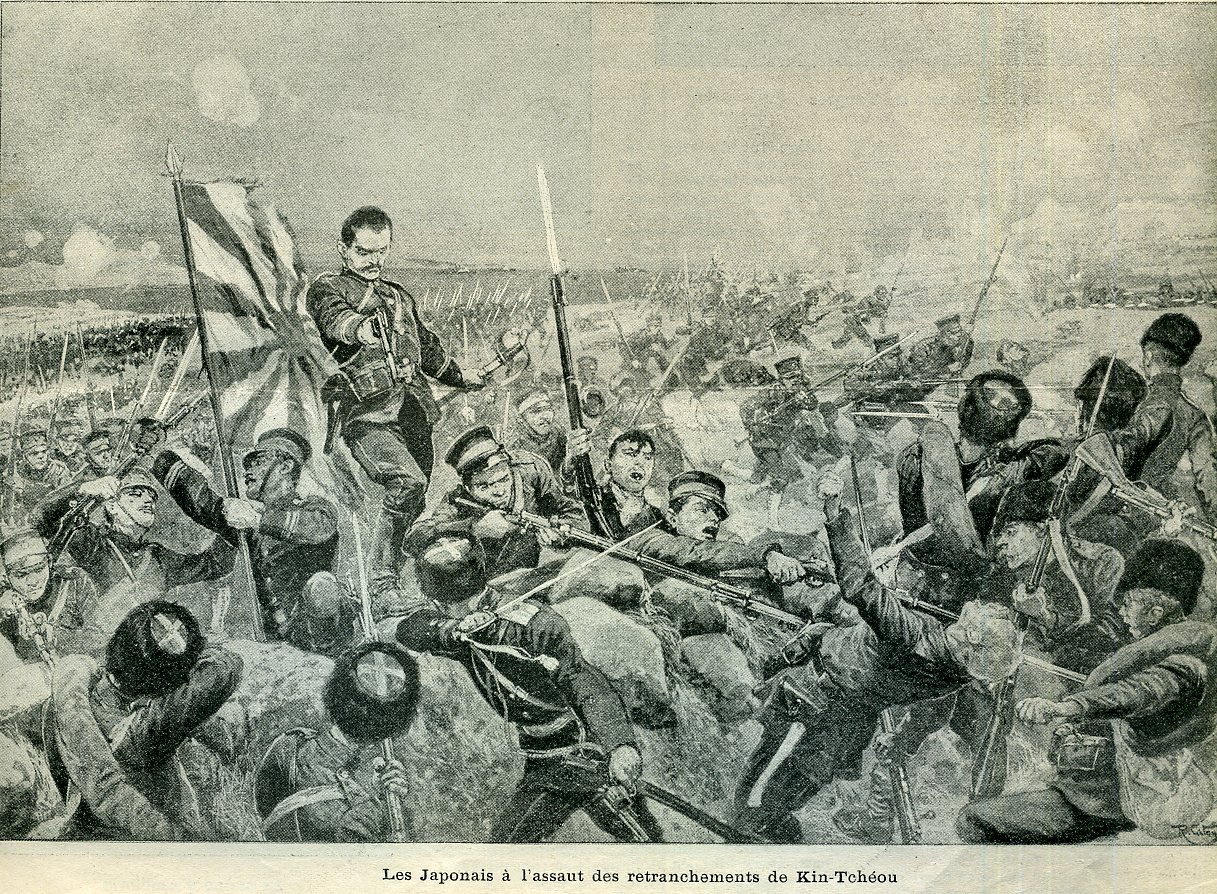
Japanese assault on the entrenched Russian forces, 1904

Japanese assault on the entrenched Russian forces, 1904
( Click image to enlarge)
Meanwhile, attempts to relieve the besieged city by land also failed, and, after the Battle of Liaoyang in late August, the northern Russian force that might have been able to relieve Port Arthur retreated to Mukden (Shenyang). Major General Anatoly Stessel, commander of the Port Arthur garrison, believed that the purpose of defending the city was lost after the fleet had been destroyed. In general, the Russian defenders were suffering disproportionate casualties each time the Japanese attacked. In particular, several large underground mines were exploded in late December, resulting in the costly capture of a few more pieces of the defensive line. Stessel, therefore, decided to surrender to the surprised Japanese generals on 2 January 1905. He made his decision without consulting either the other military staff present, or the Tsar and military command, who all disagreed with the decision. Stessel was convicted by a court-martial in 1908 and sentenced to death on account of an incompetent defense and for disobeying orders. He was later pardoned.
Anglo-Japanese Intelligence Co-operation
Even before the war, British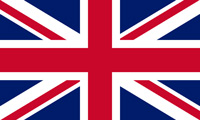 The United Kingdom of Great Britain and Ireland was a sovereign state in Northwestern Europe that comprised the entirety of the British Isles between 1801 and 1922. The United Kingdom, having financed the European coalition that defeated France during the Napoleonic Wars, developed a large Royal Navy that enabled the British Empire to become the foremost world power for the next century. and Japanese intelligence had co-operated against Russia. During the war, Indian Army stations in Malaya and China often intercepted and read wireless and telegraph cable traffic relating to the war, which was shared with the Japanese. In their turn, the Japanese shared information about Russia with the British with one British official writing of the "perfect quality" of Japanese intelligence. In particular, British and Japanese intelligence gathered much evidence that Germany
The United Kingdom of Great Britain and Ireland was a sovereign state in Northwestern Europe that comprised the entirety of the British Isles between 1801 and 1922. The United Kingdom, having financed the European coalition that defeated France during the Napoleonic Wars, developed a large Royal Navy that enabled the British Empire to become the foremost world power for the next century. and Japanese intelligence had co-operated against Russia. During the war, Indian Army stations in Malaya and China often intercepted and read wireless and telegraph cable traffic relating to the war, which was shared with the Japanese. In their turn, the Japanese shared information about Russia with the British with one British official writing of the "perfect quality" of Japanese intelligence. In particular, British and Japanese intelligence gathered much evidence that Germany The German Empire, also referred to as Imperial Germany, the Second Reich, as well as simply Germany, was the period of the German Reich from the unification of Germany in 1871 until the November Revolution in 1918, when the German Reich changed its form of government from a monarchy to a republic. During its 47 years of existence, the German Empire became the industrial, technological, and scientific giant of Europe. was supporting Russia in the war as part of a bid to disturb the balance of power in Europe, which led to British officials increasingly perceiving that country as a threat to the international order.
The German Empire, also referred to as Imperial Germany, the Second Reich, as well as simply Germany, was the period of the German Reich from the unification of Germany in 1871 until the November Revolution in 1918, when the German Reich changed its form of government from a monarchy to a republic. During its 47 years of existence, the German Empire became the industrial, technological, and scientific giant of Europe. was supporting Russia in the war as part of a bid to disturb the balance of power in Europe, which led to British officials increasingly perceiving that country as a threat to the international order.
Battle of Yalu River
In contrast to the Japanese strategy of rapidly gaining ground to control Manchuria, Russian strategy focused on fighting delaying actions to gain time for reinforcements to arrive via the long Trans-Siberian railway, which was incomplete near Irkutsk at the time. On 1 May 1904, the Battle of Yalu River became the first major land battle of the war; Japanese troops stormed a Russian position after crossing the river. The defeat of the Russian Eastern Detachment removed the perception that the Japanese would be an easy enemy, that the war would be short, and that Russia would be the overwhelming victor. This was also the first battle in decades to be an Asian victory over a European power and marked Russia's inability to match Japan's military prowess. Japanese troops proceeded to land at several points on the Manchurian coast, and in a series of engagements, drove the Russians back towards Port Arthur. The subsequent battles, including the Battle of Nanshan on 25 May 1904, were marked by heavy Japanese losses largely from attacking entrenched Russian positions.
Battle of the Yellow Sea
With the death of Admiral Stepan Makarov during the siege of Port Arthur in April 1904, Admiral Wilgelm Vitgeft was appointed command of the battle fleet and was ordered to make a sortie from Port Arthur and deploy his force to Vladivostok. Flying his flag in the French-built pre-dreadnought Tsesarevich, Vitgeft proceeded to lead his six battleships, four cruisers, and 14 torpedo boat destroyers into the Yellow Sea in the early morning of 10 August 1904. Waiting for him was Admiral Tōgō and his fleet of four battleships, 10 cruisers, and 18 torpedo boat destroyers.
At approximately 12:15, the battleship fleets obtained visual contact with each other, and at 13:00 with Tōgō crossing Vitgeft's T, they commenced main battery fire at a range of about eight miles, the longest ever conducted up to that time. For about thirty minutes the battleships pounded one another until they had closed to less than four miles and began to bring their secondary batteries into play. At 18:30, a hit from one of Tōgō's battleships struck Vitgeft's flagship's bridge, killing him instantly.
With the Tsesarevich's helm jammed and their admiral killed in action, she turned from her battle line, causing confusion among her fleet. However, Tōgō was determined to sink the Russian flagship and continued pounding her, and it was saved only by the gallant charge of the American-built Russian battleship Retvizan, whose captain successfully drew away Tōgō's heavy fire from the Russian flagship. Knowing of the impending battle with the battleship reinforcements arriving from Russia (the Baltic Fleet), Tōgō chose not to risk his battleships by pursuing his enemy as they turned about and headed back into Port Arthur, thus ending naval history's longest-range gunnery duel up to that time and the first modern clash of steel battleship fleets on the high seas.
Baltic Fleet Redeploys
Meanwhile, the Russians were preparing to reinforce their Far East Fleet by sending the Baltic Fleet, under the command of Admiral Zinovy Rozhestvensky. After a false start caused by engine problems and other mishaps, the squadron finally departed on 15 October 1904, and sailed half way around the world from the Baltic Sea to the Pacific via the Cape Route around the Cape of Good Hope in the course of a seven-month odyssey that was to attract worldwide attention. The fleet was forced to take this longer route after the Dogger Bank incident on 21 October 1904, where the Russian fleet fired on British fishing boats that they mistook for enemy torpedo boats. This caused the British to deny them access to the Suez Canal, thus forcing them around Africa, and nearly sparking a war with the United Kingdom (an ally of Japan The Empire of Japan, also known as the Japanese Empire or Imperial Japan, was a historical nation-state and great power that existed from the Meiji Restoration in 1868 until the enactment of the post-World War II 1947 constitution and subsequent formation of modern Japan. Economic and political turmoil in the 1920s led to the rise of militarism, nationalism and totalitarianism eventually culminating in Japan's membership in the Axis alliance. , but neutral, unless provoked).
The Empire of Japan, also known as the Japanese Empire or Imperial Japan, was a historical nation-state and great power that existed from the Meiji Restoration in 1868 until the enactment of the post-World War II 1947 constitution and subsequent formation of modern Japan. Economic and political turmoil in the 1920s led to the rise of militarism, nationalism and totalitarianism eventually culminating in Japan's membership in the Axis alliance. , but neutral, unless provoked).
The Fate of the Civilians
During the fighting in Manchuria, Russian troops routinely looted and burned Chinese villages, raped the women and killed all who resisted or who were just in the way. The Russian justification for all this was that Chinese civilians, being Asian, must have been helping their fellow Asians, the Japanese, inflict defeat on the Russians, and therefore deserved to be punished. The Russian troops were gripped by the fear of the "Yellow Peril", and saw all Asians, not just the Japanese, as the enemy. All of the Russian soldiers were much feared by the Chinese population of Manchuria, but it was the Cossacks whom they feared the most on the account of their brutality and insatiable desire to loot. Largely because of the more disciplined behavior of the Japanese, the Han and Manchu population of Manchuria tended to be pro-Japanese. Even the Japanese were much prone to looting, albeit in a considerably less brutal manner than the Russians, and summarily executed any Chinese or Manchu whom they suspected of being spies. The city of Liaoyang had the misfortune to be sacked three times within three days: first by the Russians, then by the Chinese police, and finally by the Japanese. The Japanese hired Chinese bandits known variously as the Chunguses, Chunchuse or khunhuzy to engage in guerrilla warfare by attacking Russian supply columns. Only once did the Chunguses attack Japanese forces, and that attack was apparently motivated by the Chunguses mistaking the Japanese forces for a Russian one. Zhang Zuolin, a prominent bandit leader and the future "Old Marshal" who would rule Manchuria as a warlord between 1916–28, worked as a Chunguse for the Japanese. Manchuria was still officially part of the Chinese Empire, and the Chinese civil servants tried their best to be neutral as Russian and Japanese troops marched across Manchuria. In the parts of Manchuria occupied by the Japanese, Tokyo appointed "civil governors" who worked to improve health, sanitation and the state of the roads. These activities were self-interested as improved roads lessened Japanese logistics problems while improved health amongst the Chinese lessened the dangers of diseases infecting the Japanese troops. By contrast, the Russians made no effort to improve sanitation or health amongst the Chinese they ruled over, and destroyed everything when they retreated. Many Chinese tended to see the Japanese as the lesser evil.
HISTORY
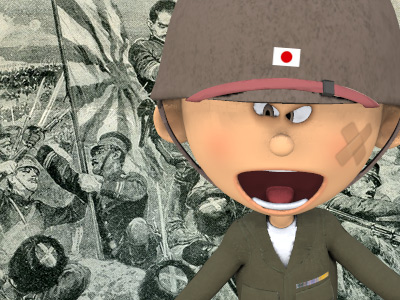
RESOURCES
This article uses material from the Wikipedia article "Russo-Japanese War", which is released under the Creative Commons Attribution-Share-Alike License 3.0.
© Stories Preschool. All Rights Reserved.
